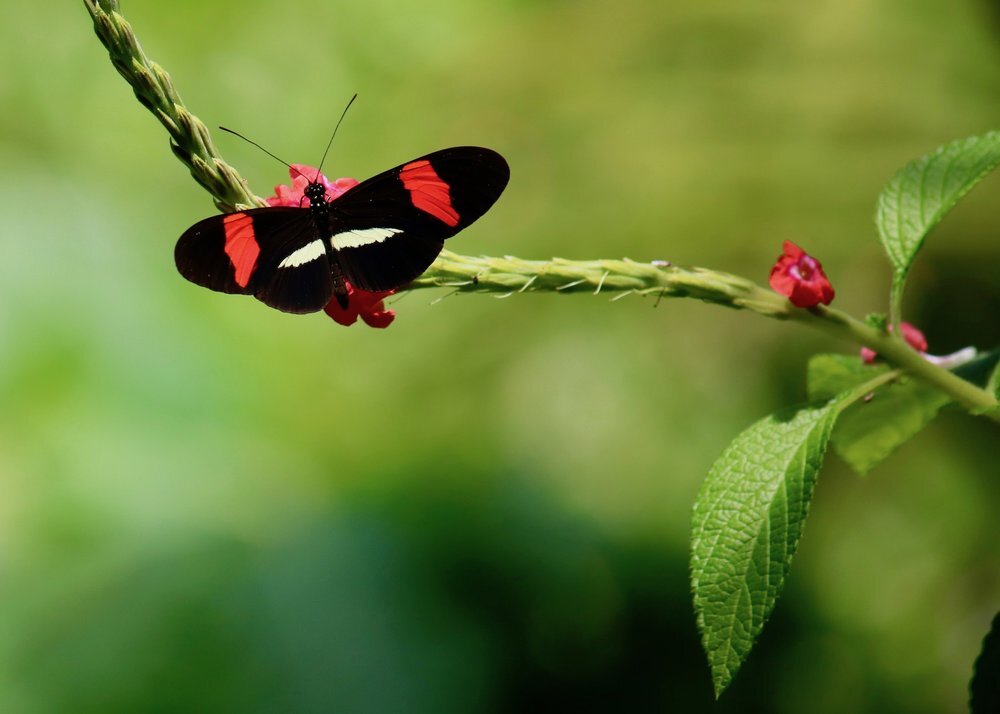Heliconius Butterfly
by Bethan (Resident Biologists from the University of Cambridge)
Evolution is a master artist, and butterfly wings are perfect canvases for evolution, leading to impressive displays of pattern and mimicry. One of the most fascinating and well-researched examples can be found right here in the tropical gardens of Golfo Dulce Retreat in Costa Rica.
Heliconius are an enchanting group of butterflies that have characteristic black elongated wings, over which evolution has painted splashes of colour, ranging from thin yellow and red bands in some species to large swathes of mottled orange in others.
These butterflies are famous for the wing pattern mimicry. Nature favours the copycat: the world is teeming with examples of mimicry, from hoverflies that look like wasps to harmless snakes passing as their venomous counterparts.
The classic case of mimicry is when a harmless species mimics a toxic species, termed Batesian mimicry. Yet, Heliconius butterflies are not so straightforward. They engage in Mullerian mimicry: all are toxic, and both species in each mimicry pair benefit from evolving matching wing patterns.
For example, two of the Heliconius species at Golfo Dulce Retreat are Heliconius melpomene and Heliconius erato. Known as “the postman” and “the small postman”, they have a red band on the forewing and a yellow band on the hindwing. They are indistinguishable except in close-up photos, where you can spot a slight difference with the hindwing yellow stripe: in Heliconius melpomenethis curves up, and in Heliconius erato it curves down.
Heliconius melpomene
Heliconius erato
In Batesian mimicry, the harmless mimic can steal some of the protection awarded when predators avoid toxic patterns. What advantages could Mullerian mimicry confer to these butterflies?
The answer lies in the dynamics of predator avoidance. The potential predators for the Heliconius butterfly, like many other butterflies, are birds. Because they are toxic, birds find the Heliconius butterfly distasteful, as they discover when they naively catch some of the butterflies. By trial and error, they learn to associate the Heliconius colour patterns - such as the yellow and red bands of Heliconius melpomeme- with the unpleasant taste, and avoid them in future.
Imagine yourself in the position of Heliconius erato in this situation. The birds have learnt to avoid little black butterflies with red and yellow stripes because they are toxic. You are also toxic, but the birds don't know that yet. Would you be better off showing your own warning pattern for the birds to learn, or copying Heliconius melpomene's pattern?
The best option is of course to copy Heliconius melpomene's pattern. Although, that's only a simple approximation to what has actually happened. Heliconius melpomene and Heliconius erato are sister species: they are closely related to each other, siblings in the family tree of life. They diverged a few hundred thousand years ago. From that point on, they have evolved independently but in parallel, like siblings growing up and changing individually, yet covertly copying each other's mannerisms so they continue to be similar to each other. In other words, every time evolution adds a new brushtroke to one species, it is compelled to add a matching brushtroke to the other - otherwise it will face heavy disapproval from its major critic, predator avoidance.
This process has played out over hundreds of thousands of years for multiple pairs of Heliconius butterflies. Another example is Heliconius hewitsoni and Heliconius pachinus, the latter of which can be found around Golfo Dulce Retreat’s gardens as well. These two have yellow stripes on both hindwings and forewings, the difference this time being whether the forewing band passes above or below a major vein in the wing.
Heliconius pachinus
Heliconius hewitsoni
Sometimes this Mullerian mimicry includes other species as well: Heliconius ismenius, also found at the Retreat, is confusingly similar to a number of other orange butterflies from other genera.
Heliconius ismenius
Predator avoidance is not the only art critic that evolution must impress. The wing pattern must satisfy species-specific mating, which means butterflies must be able to distinguish between members of their own species and the mimic's. To please these conflicting critics, evolution has a few tricks up its sleeve. Firstly, it doesn't only paint in visible colours. Heliconius wing scales can reflect UV light, which visual modelling experiments have determined can't be seen by birds’ eyes - but can be seen by Heliconius eyes. Evolution can paint pairs in matching visible patterns, but different “invisible” UV patterns. The tricks don't stop there. Heliconius, like many butterflies, use species-specific pheromones to signal to possible mates - this is a multi-media piece of art.
So much for the artist, the canvas and the critics. There's a missing piece in this story: the paintbrushes. These are the genes and cells during development, which evolution tinkers with, to change the way it paints the butterflies as embryos and pupae. State-of-the-art CRISPR studies that cut and paste genes then observe the effects on pattern development have started to yield some insights into which genes play a role. So far, wing pattern development appears to be modular: separate genes effectively control individual bands of colour. Evolution paints each brushtroke with a different paintbrush, meaning it's easy to change one mark without having too many knock-on effects on the others.
Although this makes design changes easy, another study has found that Heliconius numata links all these genes together under the control of one master switch: a so-called supergene. For this species, it's safer to keep these pattern elements locked together, so as not to end up with mismatching patterns unsuitable for mimicry.
Most of these different research projects have been conducted in nearby Panama, but these same species can be found around the gardens of Golfo Dulce Retreat and along the hike to the waterfall. The tree trail loop is also a good place to spot them. Whether flying or feeding, they are enchanting butterflies - and all the more so for their complex evolution and development.
Further reading on this topic:
Rainforest Excursions: Waterfall Expedition





